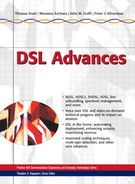5.4. Information Field Structure
The next step is to define the data structure of the message field. The message field, shown in Figure 5.4, consists of three components in the following sequence:
The identification (I) field
The standard information (S) field
The nonstandard information (NS) field
Figure 5.4. Message field structure.
![]()
The identification field identifies the message type, the revision number of the G.994.1 Recommendation that the equipment is following, identification of the equipment vendor or manufacturer, and identification of parameters independent of the mode of operation. The standard information field contains parameters that represent the modes of operation or capabilities of the DSL transceivers. The non-standard information field is used to pass non-standard information. Prior knowledge of equipment is required to read and understand the information transmitted via the nonstandard facilities, and this is identified via the vendor ID codes in the information field. A data structure for the non-standard field is also defined in G.994.1.
Both the identification (I) and standard information (SI) fields contain an array of parameters relating to particular modes of operation, features, and/or capabilities associated with the two end modems. G.994.1 defines a data structure that allows future extension of the parameter list in such a way as to permit present and future G.994.1 implementations to correctly parse the information fields. The following summarizes the rules for encoding data to be transmitted in the I and S information fields.
The general data structure for defining parameters in the I and S fields that is adopted in G.994.1 is a three-level tree structure. This three-level tree structure is illustrated in Figure 5.5.
Figure 5.5. Tree data structure of the I and S parameter fields.

